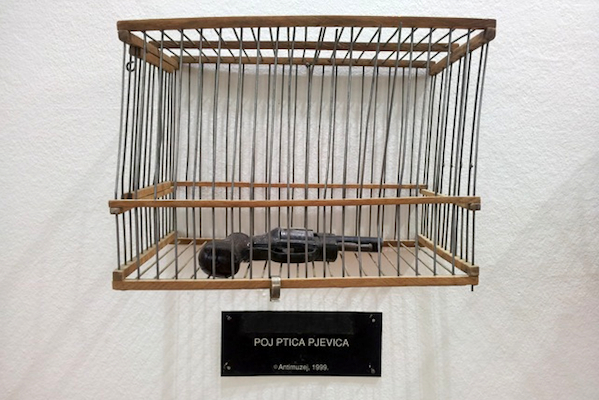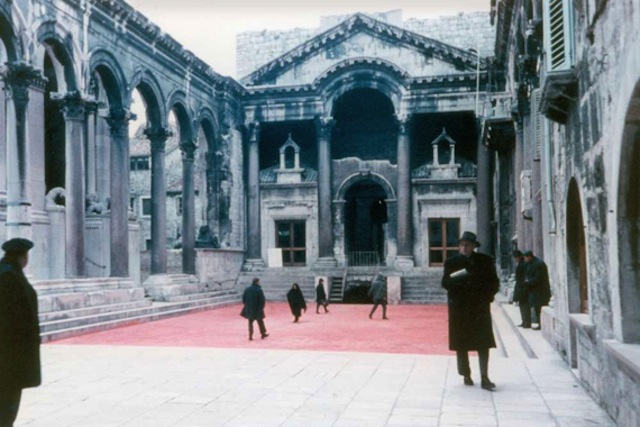Art, Featured
Collecting as art: Vladimir Dodig Trokut’s Antimuseum revisited
Artist Vladimir Dodig Trokut is both a legend and an enigma in Croatia. Although he has been present on the creative scene since the 1960s and is highly prolific, his work has yet to be seriously critically evaluated. Perhaps this is partially because Trokut creates on the margins – he does his own thing, so to speak, and operates relatively independently of the Croatian contemporary art scene. Or perhaps it’s because many just aren’t sure what to make of his approach to creating and collecting.
Early on, Trokut was associated with the alternative art scene in Split, where in 1968, a group of artists known as Crveni peristil (Red Peristyle) painted the peristyle of Diocletian’s Palace red as a political statement. Trokut did not participate in this particular act, and was instead part of a faction of the group that considered themselves “anthropological anarchists,” not because they advocated societal destruction, but because they hoped to make changes in the way culture functioned.
This interest in anthropology, along with the subversive, anti-institutional art practices of the 1960s, was likely the stimulus for Trokut’s Antimuseum, a massive collection of everyday, found objects that he has gathered over the past four decades. The collection is an “antimuseum” not so much because Trokut is anti-institutionalist, but because it exists outside of any established museological practice, as it comprises ordinary objects, artwork by the artist himself, and artwork by other artists, and additionally, it is simultaneously a collection and an art project.
Trokut’s Antimuseum now numbers over 500,000 objects, so when I received an invitation to his home, I expected an unnavigable tangle of bric-a-brac. Actually, though, his modest apartment contains only a fraction of his collection and resembles a curated cabinet of curiosities. As Trokut moves through his home, pointing out specific objects and recounting detailed facts, anecdotes, and dates about each, his devotion and care toward his collection becomes evident.
Through his trademark beard, in his quiet and muffled way, Trokut explains that his home is actually something between a living museum and an ongoing art project. “[This is] is all together one installation. The concept is a working space that can actually be a type of museum, a laboratory of curiosities … a muzej za svaki dan (museum for every day).”
His kitchen, which he has titled Trokut Kuhinja (Trokut Kitchen), constitutes one part of the museum. It is filled with ceramic jars for flour and sugar, antique butter molds and cake pans, a device to keep milk from burning, a refrigerator from the 19th century, and a sink made out of an old steel barrel. A collection of canes hangs overhead. The cane Trokut always carries with him, he tells me, he swapped with the influential artist Joseph Beuys. (Trokut also gave Beuys his trademark hat.)
The walls of the entryway display Trokut’s assemblages – three-dimensional collages pieced together from various found objects, demonstrating a keen eye for composition, color, and visual wit in the form of cleverly arranged of objects and unexpected phrases. Trokut refers to these as “poetic installations,” mixed-media constructions made from elements of his former poems, some of which express the kabalistic relationship of fulfillment and emptiness. Trokut always uses elements from previously exhibited works to build new assemblages, so his poetic installations are interconnected and organic, and each holds hidden layers of meaning often related to various forms of mysticism.
“The principles of my work are based on alchemy, shamanism, occultism … All of this work, no matter what the form, has the form of an alchemic message,” he explains. During the creative process, he first senses objects and meditates on their energy, which then comes out in their new form. In other words, rather than create something from nothing, Trokut works with existent objects, transforming them into something new and perhaps even truer to their inherent energy. He prefers, for example, to paint not on a new, blank canvas, but on a discarded canvas carrying an image painted by a student from the academy, and although he studied as a sculptor in traditional media, he would rather work with found objects.
This is likely one reason Trokut’s Antimuseum has grown so large and varied. Much of the collection was recovered from trash heaps; many objects were acquired when businesses closed down. So there are now various sub-collections within the Antimuseum, for example artifacts from hair salons, laboratories, cobblers, milliners, tailors, and button factories.
Trokut points out that he began collecting these objects in the 1970s, when institutions were generally not interested in the trivial paraphernalia of everyday life. So now, his Antimuseum is an incredible resource of cultural history. Unfortunately, however, Trokut has not found a suitable space for his Antimuseum, which is currently stored in over 30 locations across Croatia and subject to environmental damage and break-ins. Trokut has offered to donate the collection to the Republic of Croatia on the condition that they provide a suitable space for it, but as of yet, no space has been secured.
Ideally, where would such a collection find its home? Trokut envisions an industrial archaeological space from the 19th century housing that would become a “dynamic museum, a museum of change.” Drawing from those sub-collections of artifacts, Trokut would fill the museum with installations that reimagine different environments, for instance an entire laboratory or salon recreated as an installation. This approach highlights the difference between Trokut’s Antimuseum and a traditional museum: rather than simply display these objects, he intends to assemble artistic installations with them, creating a physical and spatial experience of toyed-with chronology and context.
Certainly, Trokut’s Antimuseum is valuable on many levels. Not only does it contain his rich and layered work, created according to a highly individual and perceptive process, it also speaks to his legacy as a dedicated collector, curator, and museologist. Were the Antimuseum to find a suitable home, and Trokut’s vision for it was fully realized, it would introduce a new breed of museum: one in which preservation and display becomes a layered and intricate work of art itself.
Interview and images by: Elaine Ritchel (@elaineritchel)
Image source (‘Crveni Peristil’): The Analogous City











